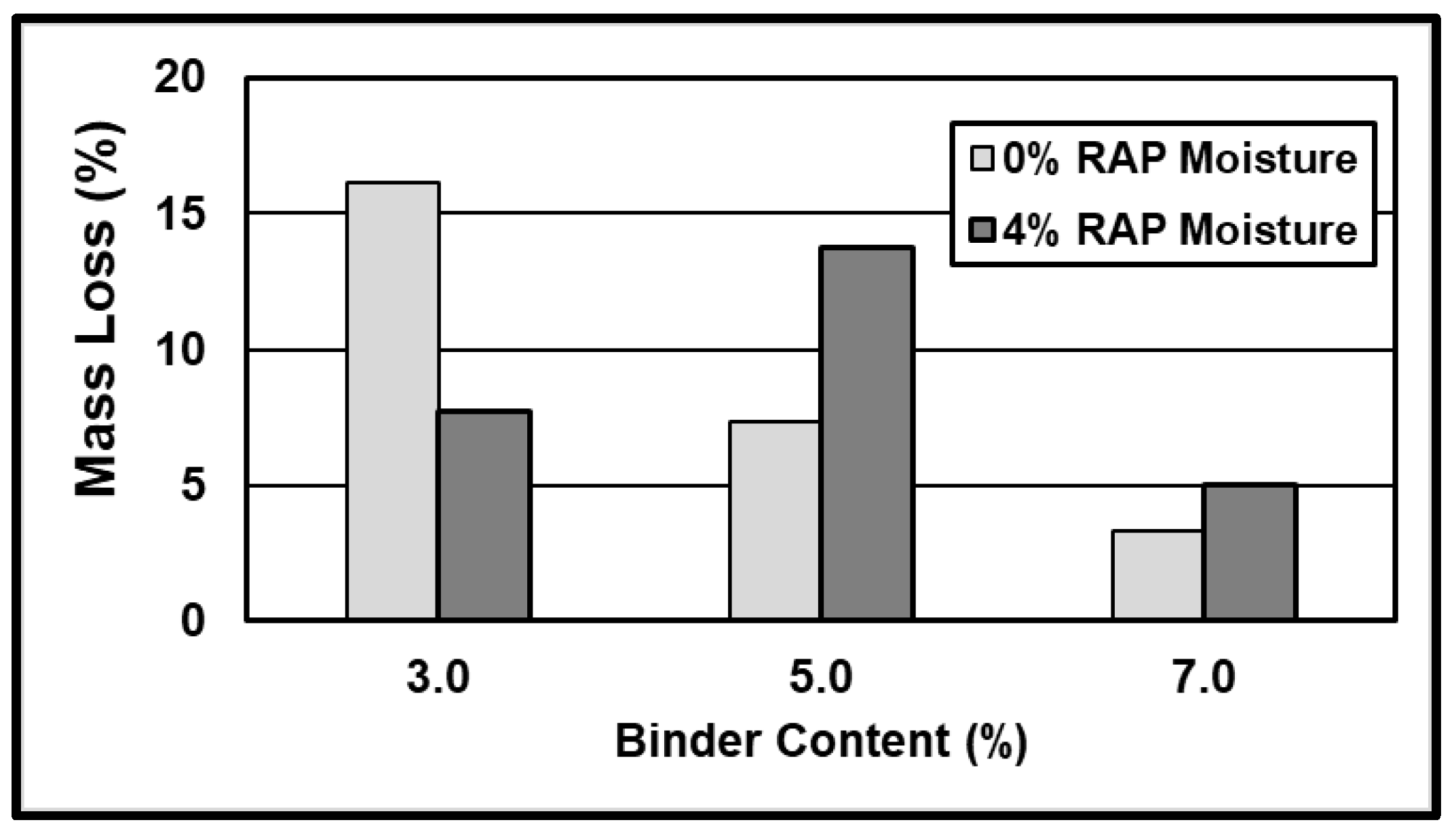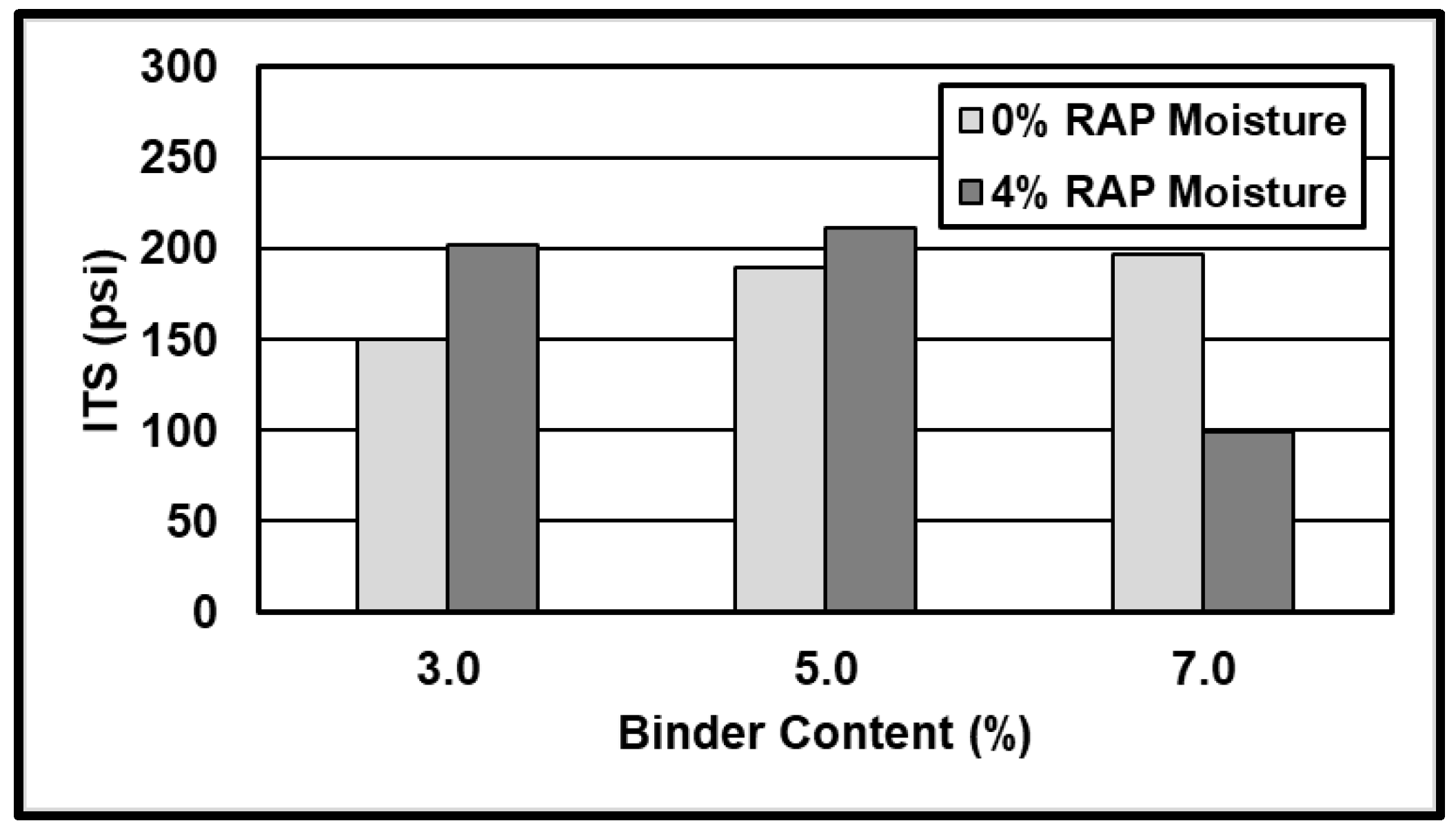Laboratory Evaluation of Recycled Asphalt Pavement and Engineered Polymer Binder for Small Airfield Repairs †
Abstract
:1. Introduction
2. Materials and Methods
3. Results and Discussion
4. Conclusions and Recommendations
Author Contributions
Funding
Data Availability Statement
Acknowledgments
Conflicts of Interest
References
- Rushing, J.F.; Cox, B.C.; Floyd, W.C. Rutting Performance of Cold-Applied Asphalt Repair Materials for Airfield Pavements. In Airfield and Highway Pavements; American Society of Civil Engineers: Philadelphia, PA, USA, 2017; pp. 185–195. [Google Scholar]
- Wang, T.; Dra, Y.A.S.S.; Cai, X.; Cheng, Z.; Zhang, D.; Lin, Y.; Yu, H. Advanced cold patching materials (CPMs) for asphalt pavement pothole rehabilitation: State of the art. J. Clean. Prod. 2022, 366, 133001. [Google Scholar] [CrossRef]
- Han, S.H.; Lee, S.Y.; Rhee, S.K.; Kwon, B.J. Development of a Spray-Injection Patching System and a Field Performance Evaluation of 100% RAP Asphalt Mixtures using a Rapid-Setting Polymer-Modified Asphalt Emulsion. Int. J. Highw. Eng. 2018, 20, 77–85. [Google Scholar] [CrossRef]
- Mejias-Santiago, M.; Del Valle-Roldan, F.; Priddy, L.P. Certification Tests on Cold Patch Asphalt Repair Materials for Use in Airfield Pavements; ERDC/GSL TR-10-14; U.S. Army Engineer Research and Development Center: Vicksburg, MS, USA, 2010. [CrossRef]
- Cox, B.C.; Floyd, W.C.; Rushing, J.F.; Rutland, C.A. Rapid Inductive Heating of Asphalt Concrete to Hot Mix Temperatures for All-Season Pothole Patching: Feasibility Study. Transp. Res. Rec. J. Transp. Res. Board 2019, 2673, 477–491. [Google Scholar] [CrossRef]
- Hajj, E.Y.; Piratheepan, M.; Sebaaly, P.E. Performance Evaluation of a Polymer Binder Stabilized Aggregate Mixture: A Pilot Study. In Airfield and Highway Pavements; American Society of Civil Engineers: Philadelphia, PA, USA, 2017; pp. 406–415. [Google Scholar] [CrossRef]
- Hajj, E.Y.; Piratheepan, M.; Sebaaly, P.E. Performance evaluation of a 100% recycled asphalt pavement mixture using a polymer binder: A pilot study. In Bearing Capacity of Roads, Railways and Airfields; CRC Press: London, UK, 2017; pp. 1217–1224. [Google Scholar]
- Howard, I.L.; Cooley, L.A., Jr.; Doyle, J.D. Laboratory Testing and Economic Analysis of High RAP Warm Mixed Asphalt; Report FHWA/MS-DOT-RD-08-200; Mississippi Department of Transportation: Jackson, MS, USA, 2008; p. 104.
- Watson, D.E.; Cooley Jr, L.A.; Moore, K.A.; Williams, K. Laboratory Performance Testing of Open-Graded Friction Course Mixtures; Transportation Research Record No.1891; Transportation Re-Search Board: Washington, DC, USA, 2004; pp. 40–47. [Google Scholar]
- Mejías-Santiago, M.; Doyle, J.D.; Howard, I.L.; Brown, E.R. Evaluation of Warm-Mix Asphalt Technologies for Use on Airfield Pavements; ERDC/GSL TR-12-3; U.S. Army Engineer Research and Development Center: Vicksburg, MS, USA, 2013.
- Doyle, J.D.; Howard, I.L. Characterization of Dense-Graded Asphalt with the Cantabro Test. J. Test. Eval. 2014, 44, 77–88. [Google Scholar] [CrossRef]
- Cox, B.C.; Smith, B.T.; Howard, I.L.; James, R.S. State of Knowledge for Cantabro Testing of Dense Graded Asphalt. J. Mater. Civ. Eng. 2017, 29, 04017174. [Google Scholar] [CrossRef]
- Doyle, J.D.; Robinson, W.J.; Stache, J.M.; Cox, B.C. Consideration of a Tack Coat Bond Strength Test to Minimize the Potential for Slippage Failures on Flexible Airfield Pavements. Transp. Res. Rec. J. Transp. Res. Board 2022, 2676, 374–388. [Google Scholar] [CrossRef]
- Cox, B.C. Cold In-Place Recycling Characterization Framework for Single or Multiple Component Binder Systems; Mississippi State University: Starkville, MS, USA, 2015. [Google Scholar]



| % Binder | % RAP Moisture | Avg Gmb |
|---|---|---|
| 3 | 0 | 1.979 |
| 4 | 2.079 | |
| 5 | 0 | 2.038 |
| 4 | 2.048 | |
| 7 | 0 | 1.985 |
| 4 | 1.986 |
Disclaimer/Publisher’s Note: The statements, opinions and data contained in all publications are solely those of the individual author(s) and contributor(s) and not of MDPI and/or the editor(s). MDPI and/or the editor(s) disclaim responsibility for any injury to people or property resulting from any ideas, methods, instructions or products referred to in the content. |
© 2023 by the authors. Licensee MDPI, Basel, Switzerland. This article is an open access article distributed under the terms and conditions of the Creative Commons Attribution (CC BY) license (https://creativecommons.org/licenses/by/4.0/).
Share and Cite
Carruth, W.D.; Floyd, W.C.; Tingle, J.S. Laboratory Evaluation of Recycled Asphalt Pavement and Engineered Polymer Binder for Small Airfield Repairs. Eng. Proc. 2023, 36, 9. https://doi.org/10.3390/engproc2023036009
Carruth WD, Floyd WC, Tingle JS. Laboratory Evaluation of Recycled Asphalt Pavement and Engineered Polymer Binder for Small Airfield Repairs. Engineering Proceedings. 2023; 36(1):9. https://doi.org/10.3390/engproc2023036009
Chicago/Turabian StyleCarruth, William D., Webster C. Floyd, and Jeb S. Tingle. 2023. "Laboratory Evaluation of Recycled Asphalt Pavement and Engineered Polymer Binder for Small Airfield Repairs" Engineering Proceedings 36, no. 1: 9. https://doi.org/10.3390/engproc2023036009
APA StyleCarruth, W. D., Floyd, W. C., & Tingle, J. S. (2023). Laboratory Evaluation of Recycled Asphalt Pavement and Engineered Polymer Binder for Small Airfield Repairs. Engineering Proceedings, 36(1), 9. https://doi.org/10.3390/engproc2023036009






